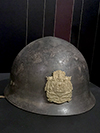|
trah phaen din (ตราแผ่นดิน)
Thai. Name for the Royal Arms of
Siam until 1911, when the Garuda or Krut (fig.) was introduced as the national state symbol of Thailand. Before that time, the Kingdom of Siam had no official arms, and used the trah phaen din as its coat of arms. It was designed in 1873 by Prince Momchao Prawich Chumsai (ประวิช ชุมสาย), who in 1873 also designed the trah lohkhen tamruat (fig.). The Royal Arms appeared in somewhat variable forms (fig.), yet in general it consisted of the Great Crown of Victory (fig.) with beams of light emanating from it, flanked by two chattra, i.e. multi-layered parasols (fig.) and a symbol of kingship. Under the crown is the symbol of the Chakri Dynasty, i.e. a chakra disc intersected with a trident (fig.). Underneath those is a shield which is partitioned into three sections, with in the top part the three-headed elephant Erawan (fig.), i.e. the symbol of ancient Siam (fig.) and signifies the Thai part of the Kingdom. On the bottom left section of the shield is another elephant, which refers to the Laotian suzerainty (the old name for Laos was Lan Chang, i.e. a ‘Million Elephants’), whereas the bottom right section of the shield depicts two crossed Malayan short swords, known as kris (fig.), which represent the Malay suzerainty. Additionally, the parasols may be held by a Royal Lion known as Raja-singha on the right and by a Gajasingha of the type Takkatoh (fig.) on the left, with in the background a draped royal robe. Also the other regalia (fig.) are usually depicted, i.e. the Sword of State (fig.) and the Golden Yak's Tail (fig.) on the left, crossed with the Royal Sceptre (fig.) and the Golden Fan on the right, as well as the Golden Sandals or chalong phra baht (fig.) located at the bottom of the robe. There is also a chain of the Order of Chulachomklao, with a star-shaped pendant with the depiction of King Rama V, after whom the order was named and who initiated the use of arms in Siam. The royal robe is tied to the top of the royal sword on the left and the royal sceptre on the right, with a pink ribbon, i.e. the colour of the birthday of this king according to the sih prajam wan system. Finally, there is also a green-and-yellow rimmed red ribbon with the Pali text in Thai script sabbes sangkhaphutan samakki wuthisathika (สพฺเพสํ สงฺฆภูตานํ สามคฺคี วุฑฺฒิสาธิกา), i.e. a motto that translates into Thai as sahmaki khong moo tham hai geut suk (สามัคคีของหมู่ทำให้เกิดสุข), and may be translated as ‘unity of the masses brings happiness’. The former and unofficial coat of arms of the Kingdom of Siam is today still used as the coat of arms of the Royal Thai Police and appears in its full form on the hats (fig.) and helmets (fig.) of all police officers, as well as on the hats of cadets of the Royal Thai Armed Forces, though the insignia of the latter lacks the beams of light emanating from the Great Crown of Victory (fig.).
See also TRAVEL PICTURES.
回






|

